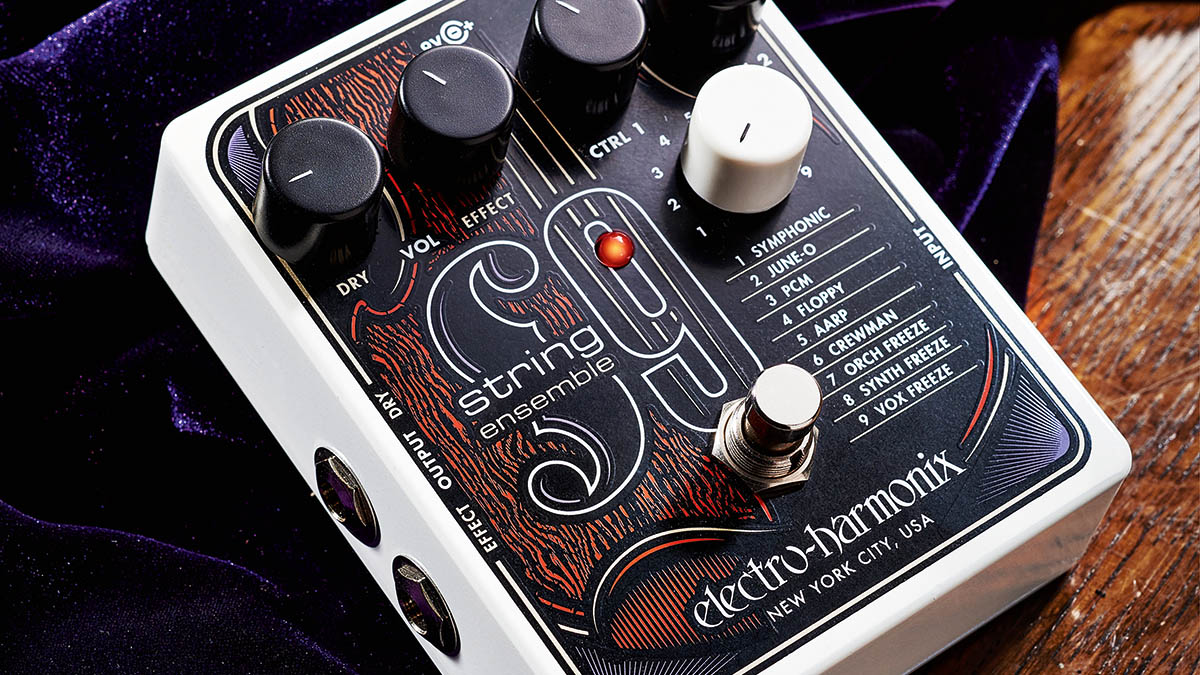Guitar World Verdict
This pedal is designed for a specialised job, and it does that job perfectly. While it’s handy if you need a substitute for a keyboard player, there are plenty of new textures on offer when you mix the strings proportionately with guitar.
Pros
- +
Instant string sounds.
- +
Flexible output options.
- +
Ability to set guitar/string blends.
Cons
- -
Manual freeze mode can take a bit of getting used to.
You can trust Guitar World
With its ‘9 Series’, Electro-Harmonix has created a minor genre in pedals that recreate the sounds of other (mainly keyboard) instruments from any electric guitar – no additional synth pickups required.
The latest, String9, has been designed to emulate orchestral and synthesiser string sounds and, to that end, offers the well-established array of nine different sounds selected by a rotary knob.
There are volume knobs for your guitar and the emulated string sound to mix at the Effects output. There’s also a Dry output, which delivers the input signal at unity gain, leaving plenty of options for your signal chain.

As with the other ‘9 Series’ pedals in the range, there are no problems with tracking here – there’s no need to have to have dry guitar sound mixed in to disguise any shortcomings, so you can have pure string sounds if you want. However, blending strings with guitar offers a lovely range of textures combining a sharp attack with lingering sustained body.
Each of the patches has its own distinctive character, though all are in the same ballpark of sustained string sounds, and each has two specific adjustable parameters enabling quite a range of variation from the basic sound.
The first program, Symphonic, offers a rich orchestral sound and can have a long fade-out time via Ctrl 2. Elsewhere in the program list you get polyphonic analogue synth and PCM digital synth strings, plus an emulation of ’60s and ’70s mechanical string machines, such as the Orchestron.
AARP offers the familiar ’70s sound of an ARP Solina string synth with optional phaser, and Crewman emulates a Crumar Performer string and brass synth with adjustable filter sweep.
All the latest guitar news, interviews, lessons, reviews, deals and more, direct to your inbox!
The last three programs – with orchestral, string synth and a Mellotron choir and strings – provide the freeze effect to sample and hold notes and chords with infinite sustain.
This offers two modes, with Auto being the most natural and creative, sustaining each note or chord until you hit another one; the footswitch-operated Manual mode is useful for a sustained string pad to play over with the dry sound.

Specs
- PRICE: $259 / £199
- ORIGIN: USA
- TYPE: Strings emulation pedal
- FEATURES: Buffered Bypass,9x patches (Symphonic, June-O, PCM, Floppy, AARP, Crewman, Orch Freeze, Synth Freeze, Vox Freeze)
- CONTROLS: Dry volume, Effect volume, Ctrl 1, Ctrl 2, Patch selector knob, internal bypass mute dipswitch (for the Effect jack), Bypass footswitch
- CONNECTIONS: Standard input, standard Dry output, standard Effect output
- POWER: Included 9V DC adaptor 100mA current draw
- DIMENSIONS: 97 (w) x 119 (d) x 52mm (h)
- CONTACT: Electro-Harmonix
Trevor Curwen has played guitar for several decades – he's also mimed it on the UK's Top of the Pops. Much of his working life, though, has been spent behind the mixing desk, during which time he has built up a solid collection of the guitars, amps and pedals needed to cover just about any studio session. He writes pedal reviews for Guitarist and has contributed to Total Guitar, MusicRadar and Future Music among others.


